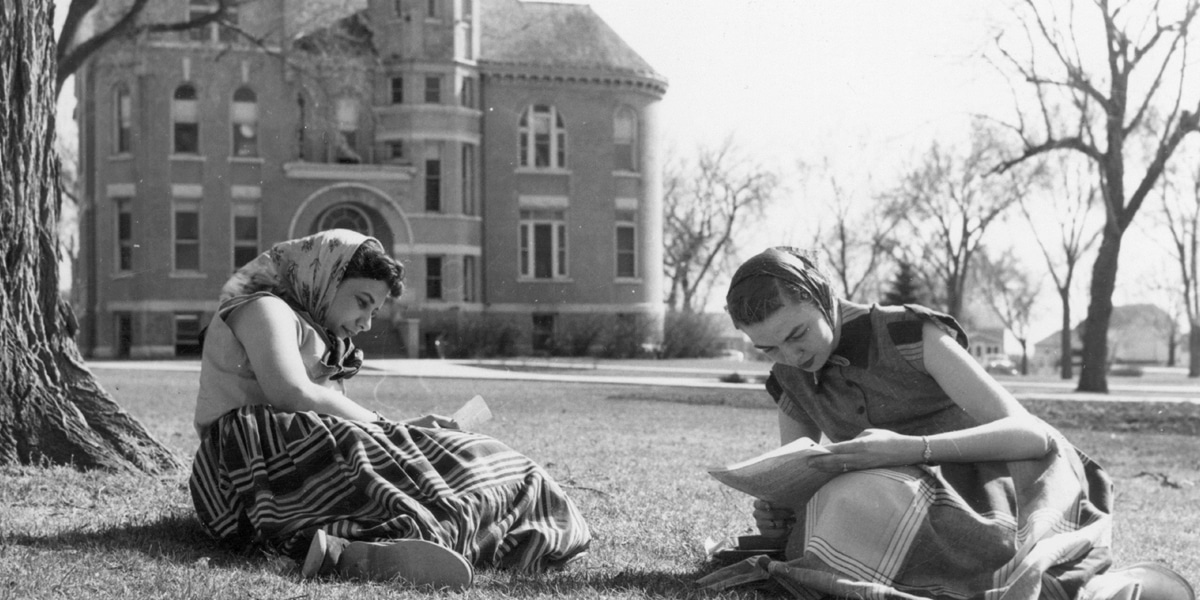
History & heritage
Northwestern is a Christian college in the Reformed tradition. That tradition goes back to the 16th-century Protestant Reformation and to the work of John Calvin. Calvinist churches spread throughout continental Europe and the rest of the English-speaking world, including North America, where their best-known representatives have been the Puritans and the Presbyterians.
Reformed Christianity was the dominant religious influence in colonial America. In the early 17th century, Dutch Calvinist immigrants settled in what is now New York, where the first Reformed Church was organized in 1628. This makes the Reformed Church in America, Northwestern’s founding denomination, the oldest Protestant denomination in North America with a continuous ministry.
Settlement of northwest Iowa
A second Dutch migration to the New World—this time to the Midwest in the 19th century—brought immigrants who desired freedom of religious expression and opportunities for a better life in general. The best-known settlements of the Dutch Reformed immigrants of this time were Holland, Michigan, and Pella, Iowa, both begun in 1847. Most of these immigrants soon joined the Reformed Church in America. In the 1870s some Pella residents led by Henry Hospers moved to inexpensive, fertile land in northwestern Iowa, about forty miles north of Sioux City. They named their main settlement “Orange City,” after the Dutch royal house.
Founding of Northwestern
In 1872, the Reverend Seine Bolks became the first pastor of Orange City’s First Reformed Church. One of the founders of what became Hope College in Holland, Michigan, he desired to establish a Christian classical academy in Orange City to prepare students for college and ultimately for ministry in the Reformed Church in America. Grasshopper scourges and intermittent floods, hailstorms and droughts delayed fulfillment of that dream.
After considerable economic hardship, the area’s Dutch Reformed people, led by Bolks and Hospers, incorporated the Northwestern Classical Academy on July 19, 1882. The constitution called for establishing an institution of learning “for the promotion of science and literature in harmony with, and religion as expressed in, the doctrinal standards of the Reformed Church in America.”
The early years
Hospers donated much of the land on which Northwestern is located. Zwemer Hall, the first permanent building, was erected in 1894; it is now the college’s administration offices and is listed in the National Register of Historic Places.
The academy grew from 25 students in the first year to around 70 within a decade. The curriculum expanded to embrace subjects such as education and business in addition to classical studies such as Latin. Soon academy graduates included educators and other professionals.
In 1928 the academy added a junior college. The Great Depression hit Northwestern hard, resulting in salary cuts for faculty. Despite the suggestion from the Reformed Church’s Board of Education in 1932 that the junior college close temporarily, President Jacob Heemstra kept Northwestern afloat. After World War II enrollment increased steadily. With that growth came the construction of a number of buildings in the 1950s.
A time of growth
Northwestern became a four-year teacher-training college, awarding its first bachelor’s degrees in 1961, the same year the academy ceased operation. Four years later, the Board of Trustees approved the development of a liberal arts program. As enrollment doubled to more than 760 in the 1960s, three dorms and Ramaker Library were built.
The North Central Association granted the college full accreditation in 1970. The football team won the college’s first NAIA national championship in 1973, and Northwestern began offering opportunities to intern in Chicago and study abroad a year later.
Northwestern’s Christian dimension was strengthened in the 1980s as the institution joined the Council for Christian Colleges & Universities, began offering spring and summer short-term mission opportunities, and emphasized discipleship groups. The percentage of faculty who earned doctorates or the highest degree in their field increased from less than 50% to 75%. In addition, majors were added in accounting, Christian education, communication, computer science and social work. Despite Iowa’s farm crisis, funds were raised to build Christ Chapel and enrollment grew to more than 1,000 by the end of the decade.
Northwestern today
Northwestern College in the 21st century is a standout higher education institution, earning awards for academic excellence, spiritual fervor, co-curricular opportunity and vibrant campus life. Two faculty members were named Iowa's Professor of the Year in 2004 and 2006, and Red Raider teams have won eight national championships since 2001. In addition to more than 135 academic program options for undergraduates, Northwestern also offers graduate and professional studies programs both online and on campus. New facilities have been constructed for art, theatre and athletics, and an impressive learning commons/library opened in 2013. Standing next to Christ Chapel, the two flank the college's entrance and signal that this is a place committed to the integration of faith and learning. The latest addition to campus is the $24.5 million DeWitt Family Science Center, built in 2018 and home to Northwestern’s impressive biology, chemistry and nursing departments.
Adhering to its original mission of providing a Christ-centered education, Northwestern identifies as Reformed in commitment, evangelical in engagement and ecumenical in spirit. As in the past, Northwestern looks to the future with confidence and faith that God’s light will continue to guide.
